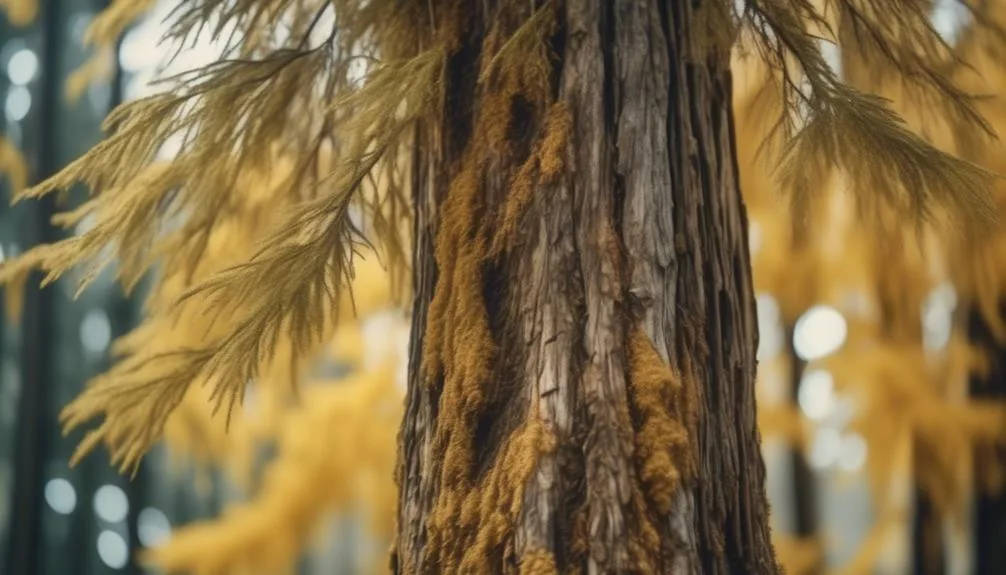Cedar trees can suffer from a hidden threat called root rot, which can seriously harm their health. But don't worry, there are ways to fight back and help your cedar trees recover.
This article will guide you through spotting the signs of root rot and using effective treatments to restore your trees to good health.
It's essential to recognize these problems early to save your beloved cedar trees from harm.
Signs of Root Rot in Cedar Trees
If you notice wilting branches, discolored leaves, or a foul odor emanating from the base of your cedar tree, these could be signs of root rot, indicating a potential problem that needs immediate attention.
Root rot in cedar trees is a serious issue that can lead to the death of the tree if not addressed promptly. Preventive measures such as improving soil drainage and avoiding overwatering can help reduce the risk of root rot.
Early detection is crucial in managing root rot, as it allows for intervention before the disease progresses. Regularly inspect your cedar tree for any signs of distress, and if you suspect root rot, consider consulting with a professional arborist for proper diagnosis and treatment.
Taking proactive steps to prevent and detect root rot can help preserve the health and beauty of your cedar trees.
Preventive Measures for Root Rot
To prevent root rot in your cedar trees, focus on implementing preventive measures such as improving soil drainage and avoiding overwatering, which are crucial in maintaining the health and vitality of your trees. Proper soil drainage is essential to prevent water from pooling around the roots, creating an environment conducive to fungal infection.
Here are five preventive measures to protect your cedar trees from root rot:
- Ensure proper soil drainage by amending heavy clay soils with organic matter.
- Use well-draining potting mix for container-grown cedar trees.
- Avoid overwatering by allowing the soil to dry out between waterings.
- Plant cedar trees in raised beds or mounds to improve drainage.
- Space cedar trees appropriately to allow for good air circulation, reducing the risk of fungal infections.
Identifying and Diagnosing Root Rot
When identifying and diagnosing root rot in cedar trees, carefully observe the foliage and look for symptoms such as wilting, yellowing, or stunted growth to determine the presence of the disease. Understanding the causes of root rot, such as excessive moisture, poor drainage, or fungal infections, is crucial for accurate diagnosis. Here's a helpful table to aid in identifying symptoms and understanding causes:
| Symptoms | Causes |
|---|---|
| Wilting of foliage | Excessive moisture in the soil |
| Yellowing of leaves | Poor drainage |
| Stunted growth | Fungal infections |
| Darkening of roots | Overwatering or waterlogged soil |
Careful observation of these symptoms and an understanding of the underlying causes will enable you to accurately diagnose root rot in cedar trees and take appropriate measures to address the issue.
Managing Root Rot in Cedar Trees
In managing root rot in cedar trees, implementing proper drainage and adjusting watering practices are essential steps in preventing the disease from spreading. Preventing moisture buildup around the cedar tree's roots is crucial to managing root rot effectively.
Here are some key strategies for managing root rot in cedar trees:
- Ensure the cedar tree is planted in well-draining soil.
- Use a mulch that allows for proper air circulation around the base of the tree.
- Avoid overwatering the cedar tree, and water it deeply but infrequently.
- Prune away any diseased or damaged roots to promote healthy growth.
- Consider using fungicidal treatments as a preventive measure, especially in areas where root rot is prevalent.
Treating Root Rot for Cedar Tree Health
After implementing proper drainage and adjusting your watering practices to prevent root rot, it's important to address any existing issues and treat the cedar tree for continued health and vitality.
Start by examining the soil composition around the tree. Ensure that the soil is well-draining to prevent water accumulation, which can exacerbate root rot. If the soil is compacted or retains too much moisture, consider incorporating organic matter or perlite to improve drainage.
Next, it's crucial to tackle the fungal infection causing the root rot. Apply a fungicide that specifically targets the root rot pathogen, following the manufacturer's instructions carefully. Additionally, prune any affected roots and branches to remove the infected areas.
Conclusion
In caring for your cedar trees, swift action and vigilance are essential in addressing root rot. By proactively implementing preventive measures, promptly identifying symptoms, and effectively managing the issue, you can safeguard the health of your trees.
Stay observant and responsive to any changes in their condition to mitigate the impact of root rot and nurture their well-being.

My interest in trees started when I first saw the giant sequoias in Yosemite.
I was a teenager then, and I remember thinking, “I need to learn more about this.”
That moment stuck with me.
A few years later, I went on to study forestry at Michigan Tech.
Since graduating, I’ve worked in a mix of hands-on tree care and community education.
I’ve spent over ten years helping people understand how to plant, maintain, and protect the trees in their neighborhoods.
I don’t see trees as just part of the landscape.
They are living things that make a real difference in our daily lives.
